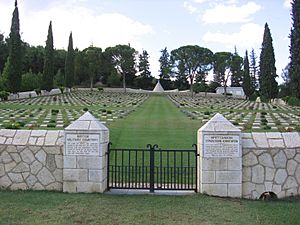Battle of Doiran (1918) facts for kids
Quick facts for kids Battle of Doiran |
|||||||
|---|---|---|---|---|---|---|---|
| Part of Vardar Offensive (World War I) | |||||||
|
1914–1918 British Military Cemetery in Polykastro (formerly Karasouli) near Lake Doiran. |
|||||||
|
|||||||
| Belligerents | |||||||
| Commanders and leaders | |||||||
|
|||||||
| Units involved | |||||||
|
|
||||||
| Strength | |||||||
| Casualties and losses | |||||||
The Battle of Doiran was a big fight during World War I. It happened on September 18-19, 1918, near Dojran Lake. In this battle, soldiers from the British and Greek armies attacked the strong defenses of the Bulgarian army. The battle was part of the war in the Balkan area. Even though the British and Greeks attacked hard, the Bulgarians successfully defended their positions.
Contents
Why the Battle Happened
The British and Greek armies started their attack from their base in Thessaloniki. At the same time, French and Serbian forces also began their own attacks. The British and Greeks, led by General George Milne, aimed to capture the Bulgarian positions around Dojran Lake. Meanwhile, the French and Serbs tried to break through Bulgarian defenses in the Vardar Valley.
This wasn't the first time the Allies tried to take Doiran.
- In 1916, a British and French attack was stopped by Bulgarian soldiers.
- In 1917, the British tried twice more but failed to capture the area.
The Bulgarian defenses were very strong. Engineers had spent many months building them. The land around Doiran was also very rough, with lots of rocks and thick bushes. Key parts of the defenses included a dangerous area called Pip Ridge and a strong point called Grand Couronné.
The Battle Begins
The battle started with a huge artillery bombardment. British forces used 231 cannons, including very powerful 8-inch howitzers. They fired for two days, even using gas shells. The infantry then advanced behind a moving wall of explosions called a rolling barrage. The British soldiers practiced a lot for this attack.
The Bulgarian side was defended by the 9th Pleven Division, led by General Vladimir Vazov. They had 122 guns and were in very well-prepared positions.
Attacks on September 18
On the left side of the battle, British and Greek soldiers attacked Pip Ridge. The British 22nd Division and the Greek Serres Division led the charge. They managed to take the first line of Bulgarian trenches. The Greek Serres Division even pushed into the second line.
However, the Bulgarians fought back fiercely. They used heavy artillery and launched counter-attacks. They quickly recaptured the ground they had lost. Many British units suffered heavy losses and could not reach their goals. By the end of the day, the British and Greek forces were back where they started.
Meanwhile, other British and Greek forces attacked north of the lake. The Greek Cretan Division and British 84th Brigade faced the Bulgarian 1st Macedonian Brigade. The Greeks attacked bravely across a wide, flat area to reach the Bulgarian positions on hills. They broke through the lines but were pushed back by strong Bulgarian fire. They tried several more times but couldn't hold their ground.
Attacks on September 19
On September 19, the British forces attacked again. The Greek Serres Division once more managed to take some Bulgarian trenches. But just like the day before, they were forced back by heavy artillery and machine-gun fire. British units also attacked but faced strong resistance and suffered many casualties. Some units lost about half of their soldiers.
The attacks north of the lake did not continue on September 19 because of the many losses from the day before. The attacks failed partly because there wasn't enough artillery support and communication problems between units.
Who Won and What it Cost
The Battle of Doiran was a victory for the Bulgarians. They successfully defended their positions against strong attacks.
The British and Greek armies suffered heavy losses. Between 6,559 and 7,819 British and Greek soldiers were killed, wounded, or went missing. Most of these losses were from the British XII Corps and the Greek Serres Division.
The Bulgarian army had fewer casualties, with 2,726 soldiers killed, wounded, or missing.
The Retreat and Aftermath
A few days after the battle, the British noticed that the Bulgarian defenses were quiet. When they advanced, they found the Bulgarian positions empty. The Bulgarian army had retreated!
This happened because French, Serbian, and Greek forces had won another big battle in the Vardar valley. This victory meant they were advancing towards Doiran. To avoid being surrounded, the Bulgarian First Army was ordered to pull back.
The British were tired and followed slowly. Bulgarian rear guards fought well, allowing the main army to escape. British planes from the Royal Air Force attacked the retreating Bulgarian columns, causing some casualties.
On September 30, Bulgaria surrendered to the Allies in Thessaloniki. This was done to avoid their country being occupied.
Years later, in 1936, the British showed great respect to General Vladimir Vazov, the Bulgarian commander at Doiran. When he visited London, British regiments lowered their flags in his honor. A British Legion leader said that General Vazov was "one of the few foreign officers whose name features in our history." This showed how much the British respected his leadership during the battle.
See also
- Macedonian front (World War I)


